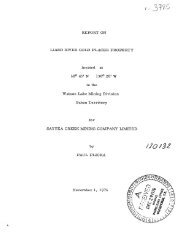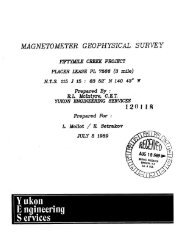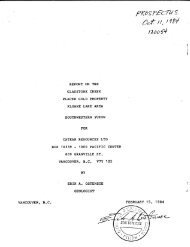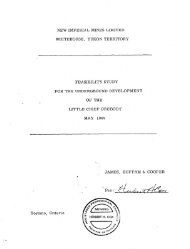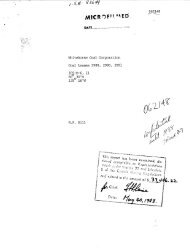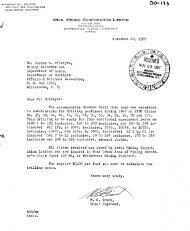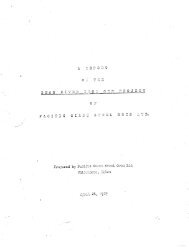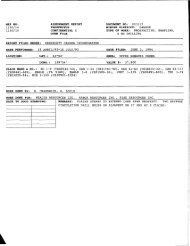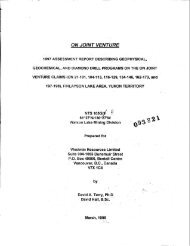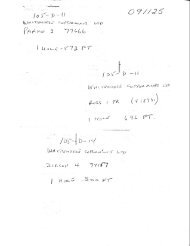GEOLOGICAL REPORT CORD CLAIMS WATSON LAKE MINING ...
GEOLOGICAL REPORT CORD CLAIMS WATSON LAKE MINING ...
GEOLOGICAL REPORT CORD CLAIMS WATSON LAKE MINING ...
You also want an ePaper? Increase the reach of your titles
YUMPU automatically turns print PDFs into web optimized ePapers that Google loves.
<strong>GEOLOGICAL</strong> <strong>REPORT</strong><strong>CORD</strong> <strong>CLAIMS</strong><strong>WATSON</strong> <strong>LAKE</strong> <strong>MINING</strong> DIVISIONYUKON TERRITORYLocationNTS: lO5B-1Latitude:Longitude:60~04'5~1 30° 15'20"ForBellabon Resources Corporation1520 - 625 Howe StreetVancower, British ColumbiaV6C 2T6Peter A. Christopher, Ph.D., P.Eng.Peter Christopher & Associates Inc.3707 West 34th AvenueVancower, British ColumbiaV6N 2K9
TABLE OF CONTENTSPAGESUMMARYINTRODUCTIONLOCATION AND ACCESSTOPOGRAPHY<strong>CLAIMS</strong> AND HISTORYREGIONAL GEOLOGYMINERAL DEPOSITS IN THE AREADISCUSSION OF THE <strong>CORD</strong> CLAIM AREACONCLUSIONS AND RECOMMENDATIONSCOST ESTIMATESBIBLIOGRAPHYCERTIFICATE122336102122242628LIST OF ILLUSTRATIONSFIGURE 1FIGURE 2FIGURE 3FIGURE 3AFIGURE 4Location MapClaim MapRegional Geology, Rancheria AreaRegional Geology, Midway AreaStratigraphic Column, Midway Deposit AreaTABLETABLE ITABLE 2Summary of Cord Claim DataLegend for Figure 3A
SUMMARYThe Cord Claims are situated about 13 kilometres (8 miles) north of the RegionalResources "Midway" silver-lead-zinc deposit and about seven kilometres (4 miles)north of Regional Resources Ewan barite deposit. Considering the proximity of theCord Claims area to the Midway deposits and the similar geological settings, a basic(Stage I) exploration program of prospecting, mapping, geophysics and rock, silt andsoil geochemistry is highly recommended for the property. The Stage I program isestimated to cost $50,000. If the Stage I program is successful in defining stronganomalies or silver-lead-zinc or barite mineralization, then a Stage I1 diamond drillingprogram will be warranted. A 400 metre diamond drilling program is estimated to cost$100,000.
INTRODUCTIONThe Cord 1 to 38 mineral claims are situated eight miles (13 kilometres) north of the"Midway" silver-lead-zinc deposit and are separated from the Midway property by theWind and Sun claims. Discovery of thesilver-lead-zinc stratiform mineraldeposit near the Tootsee River in 1981 by Regional Resources has encouraged reevaluationof adjacent areas with similar geology for silver-lead-zinc-barite deposits.The Cord claims cover some of the favourably situated ground. Figure 1 shows thelocation of the Cord property with respect to the llMidwayll and other significantmineral deposits in Northern British Columbia and Yukon Territory.This report reviews the general geological setting of the Cord Claims and other silverlead-zincproperties in the area, and outlines a recommended initital (Stage I) programand a follow-up (Stage 11) program for evaluating the economic potential of the CordClaim Area. Snow conditions prevent a useful field examination of the property atthis time and therefore, the Stage I program is based on the writer's experience withother Selwyn Basin and Kechika Trough lead-zinc-silver-barite exploration programs.Cost estimates are based on minimum use of helicopter time which will require carefulplanning. Casual helicopters are available at Watson Lake or at Rancheria (betweenMay and October, 1983) and periodically at Swift River (64 km) or the Pine Lake airstrip (55 km).LOCATION AND ACCESS Figures I and 11)The Cord Claims straddle the Tootsee River from about 3 to 5 kilometres from theconfluence with the Rancheria River. The claims are situated about 120 kilometres(75 miles) west of Watson Lake, Y.T. and 16 kilometres (10 miles) east of Rancheria,Y.T.,a small settlement on the ~laska' Highway.The Tootsee Lake road, a gravelaccess road which leaves the Alaska Highway at mile 701 provides four wheel driveaccess to the western boundary of the claims. The Alaska Highway passes within 3kilometres of the northern boundary of the property.A base camp adjacent to theTootsee River road could be used to explore the western Cord Claims, but a fly campwith helicopter support will be required for the initial exploration of the eastern partof the claim area.
Fuel and accommodation are available at Rancheria, and most supplies and servicesare available at Watson Lake, Y.T. which is serviced by daily jet flights fromWhitehorse to Vancouver.TOPOGRAPHYThe Cord Claims lie between 945 metres (3,100 feet) in the Tootsee River Valley and1,372 metres (4,500 feet) which gives the claim area a moderate relief of 427 metres.The claims are situated in the Tootsee River valley and straddle timber line.<strong>CLAIMS</strong> AND HISTORYThe Cord Claims with grant numbers YA69696 to YA69703, YA69736 to YA69743 andYA69768 to YA69789 were recorded in February, 1983. Table I provides a summary ofpertinent claim data. Snow cover prevented field confirmation of claim data obtainedfrom staking plans and claim map 105-B-1 (Department of Northern Affairs andNatural Resources). The maximum possible ground coverage of 20.9 hectares (51.65acres) per claim could be reduced by overlap of adjacent claims or less than maximumspacing of posts. The Alaska Highway gas pipeline right-of-way passes near thenorthern boundary of the claims and would reduce the size of any claim it intersects.Field checking and recording of claim post locations is required and should be part ofthe 1983 field program.The writer suspects that the area has been staked in the past but has been unable tofind any records of previous exploration work.Table I - Summary of Cord Claim Data (NTS 105-El). Data obtained from therecording office Watson Lake, Y.T.DateClaim Name Record No. Recorded Work Due StakerCord 1-8 YA69768-775 Feb. 16/83 Feb. 16/84 Barry KomishCord 9-16 YA69736-743 Feb. 15/83 Feb. 13/84 George MillenCord 17-24 YA69696-703 Feb. 15/83 Feb. 15/84 Floyd LaursenCord 25-32 YA69776-783 Feb. 16/83 Feb. 16/84 Arnold FrankCord 33-38 YA69784-789 Feb. 16/83 Feb. 16/84 Eddie Frank
FIGURE 2. CLAIM MAP FOR <strong>CORD</strong> CLAIM AREA, BELLABON FESOURCES CORPORATION. DATA FROMGOVERNM?3NT CLAIM MAP 105-B-1 AND STAKING PLANS* FIELD CHECKING IS REOUIIED.- eoO 5'Scale in feetBOUNDARY OF GAS PIPELINETOM 1 - 34FAIRLADY ENERGYI NChBELLABON RESOURCECORPORATIONDILL 1 - 32GOLDFARM RESOURCES INC.rRUN1 - 2 8 <strong>CLAIMS</strong>LYDIA 1 - 20JANTAR RESOURCESCORPORATIONREGIONAL -AMAX- PROCANMIDWAYPROPERTYSTAR1-32MOON 1 - 28ORMEK RESOURCESCORPORATIONI1107 15' PAC APRIL 1983 130° 10'
REGIONAL GEOLOGY (Figure 3)The area of interest is situated on the east flank of the Cassiar batholith whichextends over 300 km southeasterly from Wolf Lake map sheet in the Yukon to theKechika map area in British Columbia. In the Jennings River and Cassiar-McDamemap areas and the south part of Wolf Lake area the eastern flank is underlain byPaleozoic rocks from Cambrian to Carboniferous in age and separable into two ormore contrasting assesmblages, some of which are believed to be ttallocthonous" (i.e.,deposited elsewhere and moved into place along fiat lying faults) (Gabrielse andMansy, 1980).Rocks are described by Poole (Map 10-1960) and by Gabrielse (GSC Paper 68-55, 1968);brief descriptions of the mapped units are summarized below:Units 1 and 2: (Lower Cambrian)Unit 1 consists of biotite schists, quartizite, marble and skarn, with areas of extensivesills, dykes and irregular bodies of pegmatites, particularly near the contact with theCassiar batholith.Unit 2 contains quartzite, slate and phyllite, quartz grit and fine pebble conglomerate.Adjacent to the batholith the rocks are hornfelsed.Unit 3: (Lower Cambrian)This unit, which is host to numerous lead-zinc-silver showings in the area, containsgrey limestone, grey to green argillite and slate, and dolomite. The unit is convertedto skarn adjacent to the batholith.Unit 4: (Middle Cambrian to Silurian)Slates, phyllites and limestone, buff to dark grey, with dolomite and dolomiticlimestone partly converted to skarn forms a unit which is difficult to separate fromunits 2 and 3.
CAMBRIAN TO SILURIANMIDDLE CAMBRIAN TO YLDDLC SILURIANDrUl rU#a sr rock (reavo Idlrwclroo 01 worovamo.l~n-wa, whew). .......................... P/.................................1boo11 IH~III~.I e r l r o 1 Tan.. .....IaLoad.. ....Pb' Tun#al.n.. Wl o r . A 1 1 ~ ....,. Zn.aPortion of G.S.C. bp 10 - 1960 (MoltLake), Scale I 1 in-6.5 nilor.
Unit 2 (Ordovician-Silurian)This unit contains mainly quarzites, dolomitic siltstone and thin-bedded shale andlimestone, and is probably equivalent to unit 4 in the adjacent Jennings River mapsheet.McDame Group - Unit 6:The McDame Group, dark, fetid, dolomites and limestones with abundant fossil debris,forms a distinctive marker unit. Dolomite (intraformational?) breccia is common andwhite vuggy dolomite may represent reefoid accumulations of fossils, representingshoals in a shallow platform environment. Fossil evidence indicates that the McDameGroup is Middle Devonian in age.Lower Svhester Grou~ - UnitAccording to Gabrielse (1968) "the contact of the McDame Group with the overlyingSylvester Group is almost invariably a fault." The lower part of the unit is finegrained,black, locally graphitic slates and phyllites, with grey to black bedded andribbon cherts. The upper part contains argillites, interbedded with sandstones, grit andconglomerate. Cherty, fine-grained limestone may be present near the top of the unit.Several barite-silica "exhalite" horizons are present within the lower Sylvester Groupin the vicinity of the "Midway" property. Stratigraphy in this area, within theSylvester Group is described in detail by Hylands (1981), and is shown on the followingpage, with a diagrammatic stratigraphic section (Figure 4).Upper Sylvester Group - Units 7a & 8:Massive volcanic rocks, including flows, breccias, tuffs and agglomerates withaggregate thickness of over 1500 feet form Unit 7; with ultramafic bodies (Unit 8)cutting the volcanics. The volcanics include basalt, dacite and rhyolite flows andcoarse-grained equivalent intrusive rocks are said to exist in the unit (Gordey, et a11982). Most rocks are pervasively altered to "greenstones", making them appearmassive.
Cassiar Batholith:The northwesterly trending elongate Cassiar Batholith underlies the most ruggedterrain in the map area. Much of the batholith consists of massive, homogeneousbiotite quartz-monzonite, grey in color and medium to coarse grained in texture.Other varieties include muscovite quartz-monzonite, augen gneisses, and laterpegmatitic dykes. Alteration and shearing are commonly associated features -sericitization, chloritization and albitization are prevalent in some areas.Other granitoid rock types occur in the Jennings River map sheet but are not withinthe scope of this report.Dykes:Greenstone dykes are common in the batholith and also within the adjacent Paleozoicrock units. Some of the dykes are known to be lamprophyres.Structure:The Sylvester ttallocthon" is characterized by a broad, northwesterly-trending synclinalfeature commonly referred to as the McDame Synclinorium. This feature parallels thecontact of the Cassiar batholith in a general way but is modified by smaller scale foldsconforming to embayments in the batholith, as is seen near the Marbaco property.Tight folding in Cambrian-Silurian rocks is present near Tootsee Lake. Strongnorthwest to northeast faulting has also affected the area, as is seen in theaccompanying geological map (Figure 3). Most faults are steep, normal faults such asthe north-trending, easterly dipping fault cutting through the western portion of theMidway property. Faults are marked by depressions and green dykes, some of whichare schistose, indicating continued movement.Low angle faults, probably related to the hypothesized sole fault of the allocthon, areknown to cut the Sylvester sequence in the vicinity of the Midway deposit (Hylands,198 1).
A strong shear zone trends northwest through the Cassiar batholith west of TootseeLake, and along this feature pervasive shearing and mylonization occurs over widths of2 miles.The Sylvester allocthon appears to pinch out in the vicinity of the Alaska Highway inWolf Lake map area (Figure 3). Major faults mark the northern limit at SpencerCreek. South of Rancheria River, a broad area of Sylvester and McDame group rocksis thought to represent the same mineralized units as at the Midway and Marbacoproperties.MINERAL DEPOSITS IN THE AREAThe most significant development in mineral exploration in the southern Yukon andnorthern B. C. within the last few years has been the discovery of stratiform silverlead-zincmineralization within "exhalite" massive sulphide and silica/barite horizonsin the lower portion of the Mississippian-Devonian Sylvester group.The discovery, by Regional Resources Ltd. and partners Amax of Canada and ProcanExploration Ltd. has resulted in an extensive staking program and re-evaluation ofgeological data concerning mineral showings adjacent to the "Midway" property.Several other silver-lead-zinc deposits not as yet of economic size or grade, occur inclose proximity, in Cambrian to Middle Devonian strata, and also in high grade veinswithin the Cassiar Batholith. Several of these deposits are described briefly, followinga description of the Midway property.Vein mineralization occurring at the Silver Tip showing is discussed under a separateheading.Midway Deposit:The "Midway" deposit, staked by Regional Resources in 1980 and drilled in 1981 and1982 was discovered as a result of careful exploration of the previously exploredSilverknife (Silver Tip) silver-lead-zinc showing, following investigation of stronglyanomalous silt sample results in the 1980 regional geochemical survey.
Six drill holes in 1981, totalling 853 meters indicated the presence of 3 mineralizedzones dipping southeasterly at about 30 degrees. The lowermost zone observed only indrill core overlies the McDame limestone and varies from 1 to 1.5 meters thick andcontains from 2.65 to 23.39% combined lead-zinc and from 1.25 to 22.59 oz/ton silver.This zone is locally absent and may grade laterally into siliceous, pyritic, exhalite.Four of the 6 holes encountered a "dry cavernous opening 15 cm to 150 cm wide" nearthe McDame-Sylvester contact.The lower zone consists of weakly bedded to brecciated pyrite, galena, sphalerite andcarbonate fragments in an argillaceous matrix.The middle, or "Discovery"zone, found in outcrop, occurs about 70 metersstratigraphically above the lower zone, within argillite and sandstones.This zone varies for O.5m to 1 1.2 meters in thickness and ranges in grade from 4.56 to13.36 percent combined Pb-Zn and 1.26 to 5.03 oz/ton silver.The Upper Zone is about 10 - 20 meters above the Discovery zone, ranges in thicknessfrom 0.40m to 3.17m in thickness and has combined lead-zinc grades ranging from2.62% to 13.15% and silver grades.Drilling of 18 additional holes in 1982 has proven 2.78 million tonnes (3.05 M. tons)averaging 13.3 oz/tonne silver, 12% zinc and 6.1% lead with minor but possiblyeconomic quantities of tin, bismith, gold and copper. (Richardson, Greenshields,Canada Ltd. - research report). Composite samples from core from 8 holes averaged0.023 oz/ton gold, 0.35% copper, and 0.14% tin. The deposit is now known to existover an area 2,000 feet (600m) square through a geological section of 100 ft. (30m).Definition of the deposit is not complete.The exhalite horizons can be traced for at least 14 km along strike on the southwestpart of the property and similar horizons are seen 10 km to the northeast. On thenortheast side of the property a barite exhalite 4 m-thick has been traced for 5 km infloat and outcrop.
The mineralized horizons are believed to represent sulfide rich exhalations depositedon the floor of a rif t-controlled basin up to 14 km wide (Hylands, 1981).The showings respond well to standard geochemical soil and silt sampling techniques;the Discovery showing has a broad coincident Pb-Zn-Ag-Ba anomaly, and sevenadditional areas have coincident Pb-Zn-Ag anomalies. Airborne EM and magnetometersurveys were flown and ground EM and gravity surveys were done. Two pulse EManomalies and one vector EM anomaly were verified by drilling.An idealized stratigraphic section prepared by D. G. McIntyre from company plans isreproduced in Figure 3A and a stratigraphic section used by J. Hylands for the Midwayproperty is reproduced in Figure 4.Amy (Fosco) Showings:The Amy deposit is situated approximately two miles north west of the north end ofTootsee Lake. The showings were discovered in 1948 and staked by Hudson BayExploration as the Gem Group. In 1949, 8 diamond drill holes were completed totalling2935 feet, and seven deep trenches traced the mineralized zone for 550 feet withmaximum width 7 feet in DDH - 2. The mineralization, galena, tetrahedrite,sphalerite, pyrrhotite and ankerite occurs as a replacement zone in limestone along alimestone-argillite contact and near the surface trace of the granite contact. Thezone occupies a shear zone striking north 55-65 degrees west and dipping 60 degreessouthwest.Further work on the property in 1964 by Rancheria Mining Company consisted of soilsurveys, magnetometer surveys and underground development.In the underground workings, the vein in a 66 foot section averaged 5.9 feet wide andassayed 27.4 oz/ton silver, 7.5% zinc and 7.5% lead. Further drifting along the vein in1965 disclosed a vein length of at least 419 feet. Additional bulldozer trenching onother geochemical anomalies disclosed other veins. Diamond drilling to test continuityconsisted of 24 holes totalling 7500 feet.
"LRSI;E 11.Leqend for F iwe 3a.CRETACEOUSKqmCASS IAR BATHOLITHMISSISSIPPIAN AND LATERMuQuartz monzon 1 te, granodi or l teSerpent I n lte, dun I te, per ldot l teUPPER DEVONIAN TO MISSISSIPPIANDMvSYLVESTER GROUP (UPPER)Greenstone, agglomerate; dacltlc tuff; ml nor chert, metad iorlteMIDDLE TO UPPER DEVONIANuDMIDDLE DEVONIANmDSYLVESTER GROUP (LWER)Slate, argll llte, chert, siltstone, chert-arenlte, greywacke, chertpebble conglomerate, ml nor I lmestoneMcDAME GROUPDolonl te, fossl l i ferous l imestoneCAMBRIAN, ORDOV I C I AN, AND S l LUR l AN60sDolomite, dolaltlc sandstone and sl ltstone, graptol ltlc black shale,platy sl ltstone, calcareous phyl l lte, phyl l It ice 1 lmestone skarn,hornfels, I lmestone, quartziteSymbol sHlgh-angle fault; ball on downthrown block ..................................Antiform ......;..............,..............................................Contact: defined; assumed ...................................................Road ..............................................................................Stratabound barite .......................................................... 0Stratabound massive sulphlde ................................................ +Mineral occurrence In carbonate rocks ........................................ 0ExhaIIte horlzon .....................................................................
-UNIT 4 Avv v UPPER SYLVESTER. . . . . .-: --.-. -.a. :_L. .. .....- :. - ---.-; < :. --.. - -. -. - .-. -. - . ... -. -.-. ..+=-. .- 'x:-..D MvLOWER SYLVESTERu DUNIT 30KXIIALITE - 8ARlTC ,SILICAMETRESUNIT 2bUNlT 20C XIIALITL - #ARlTC, SILICACSIIALITC- 8ARITL .SILICA. LOCALUNlT IbUNlT loArm!, SILICA.LOCALMbMoSource: Hylands, J. 1981)FIGUFtE 4MIDWAY PROPE RTYSTRATlGRAPHlC SECTIONNOVEMBER. 1981
The claims lapsed in 1969 and in 1970 the property was restaked by Fosco MiningLimited. Further underground work and drilling was done and a feasibility study wasdone by Dolmage, Campbell and Associates, who concluded that the deposit containedthe following tonnages (diluted):Category Tons Ag(oz/t) - Pb%- Zn%Measured 11,400 17.10 3.74 6.26Drill indicated 31,100 6.31 1.78 6.80Geologically inferred 68,400 no grade assignedTOTAL: 110,900The consultants further stated that "A comparison between the grade of drillintercepts near the underground workings and assays from channel samples taken fromthe drift suggests that the estimated grade in the drill indicated category is probablylow by an unknown but significant amount. The reserve estimate outlined in thisreport should not be considered as limiting the ultimate potential of the deposit".Bench scale mill tests produced a concentrate acceptable to custom smelters. Adetailed underground exploration program was recommended, but immediateproduction was not recommended at that time because of the weak price for silver($1.29 to $2.57 per ounce).In 1973, additional surface work was done, confirming sampling completed on the 4450level, and a 1400 foot crosscut and 220 feet of drifting done on the 4200 feet level.A second estimate or ore reserves was done by Chapman Wood and Griswold in 1974,who concluded that total ore reserves now were + 140000 tons as follows:Category Tons Grade Ag(oz/t) - Pb% - Zn%Measured 18,122 13.88 3.27 7.29Drill indicated 61,727 9.76 2.70 5.63Total 79,849 10.70 2.84 6.03InferredTOTAL:59,326l4O,OOOno grade assigned
The claims were acquired by Marbaco Mines Ltd. in 1980 along with adjacent claimsowned by D. Schellenberg. Marbaco performed geochemical surveys and trenchingwhich indicated additional zones could be present.At present metal prices ($15/oz Ag, 28~/lb Pb, 49c/lb ~ n), gross metal value per ton ofore (1974 reserve data) is $235.50.(The estimated grade of drill indicated reserves isprobably still low compared with measured reserves, as in the 1971 calculations). Fewrecent assay exist for gold but several samples taken from 1949 to 1967 contain 0.01to 0.02 oz/ton.Prospects are considered encouraging for discovery of additional mineralized zones atthis property.Some similarities exist between the Amy deposit and the lower most "exhaliten zone atthe Midway deposit:Both deposits occur near limestone - phyllite contacts.Solution caves are found adjacent to both deposits.Mineralogy and reserve grades are similar.Mineralization is parallel with bedding in both deposits.Amy deposit is described in most reports as a strike fault system withcharacteristics of quartz-siderite-sulphide replacement of limestone in a Shear zone.However, the possibility exists that the deposit represents a remobilized stratiformexhalite deposit, with potential for augmentation of reserves along strike and dip.Silver Tip Showing (Midway Property)The Silver Tip showing, a vein or replacement deposit, is situated three milesnortheast of Tootsee Lake. Extensive work was done on the property from 1956 to1968 by several large companies including Conwest, Canex, Noranda, Bralorne Mines
and Peerless Oil and Gas.Resources and partners.It now forms part of the Midway property of RegionalThe area is underlain by thick-bedded McDame limestone of Devonian age, overlain byMississippian-Devonian Sylvester Group phyllites. Gossan zones and galena float arefound in several zones trending north-easterly. The largest gossan zone, No. 2, rangesfrom 15 to 65 feet wide and is 700 feet long and was reported to average 5.7 oz/tonsilver, 6.2% lead and 2.9% zinc. Individual pieces of galena from the zone assay about150 oz/ton silver and 70% lead (BCMM Ann. Report 1968, p. 25-33). The same zoneintersected in several drill holes consisted of "frozen mineralized gossan". No. 4 zone,intersected in the upper adit was sampled over 38 feet by taking muck from 175 cars,the average was 13.84 oz/ton silver, and 15.4% lead. The average of the channelsamples along 40 feet in the west drift was over five feet, 0.02 oz/ton gold, 12.0ozfton silver, and 14.5% lead. The same zone, intersected in the lower adit,approximately 650 feet down the dip of the fault zone, is almost completely oxidizedand resembles "soft brown sugar". This almost completely leached material assays 0.2oz/ton silver, 0.1% lead and 4.5% zinc.Mineralized zones such as the above are localized on strong faults and fractures in theMcDame limestone, along the crest of an anticline and appear to be almost completelyoxidized to depths exceeding 600 feet from the surface. Apart from the gossan zones,considerable pyrite with minor sphalerite and galena occurs in the holes drilled in thephyllite, (presumably Sylvester Group), and minor galena and sphalerite occur in quartzand calcite veins and in limestone. To the writer's knowledge, fresh vein materialfrom which the gossans resulted has not been seen on the property.This vein-replacement deposit, as yet untested by Regional Resources has strongsimilarities to the Amy deposit of Marbaco Resources. Mineralogy and grades aresimil'ar and probably origin by replacement along fault zones in limy horizons seemsalmost certain. Considering the presence of mineralization over a vertical range ofover 650 feet and 5 foot mining width, the eventual development of economic reserveson this portion of the property seems certain.
YP Property:The YP property, adjacent to the Flo and Lydia claims, situated 4 km south of mile701 on the Alaska Highway, owned by Flame Petro Minerals Ltd. and currently beingexplored by Butler Mountain Resources Ltd., has several oxidized vein or replacementzones in limestone of unknown, but probable Cambrian age. Some solid galena washand-cobbed and shipped from the property in the 1960's. Several large gossan zones,with residual argentiferous galena, are thought to represent oxidized replacementzones of galena-tetrahedrite-sphalerite and other sulphides in siderite gangue,comparable with zones present on the Silver Tip showing of the Midway property.Geochemical surveys, geologic mapping, trenching and drilling were recommended byB.J. Price in 1980. The property was reviewed in 1982 by Glen E. White, P.Eng., whosuggested pulse EM surveys in addition to geology and geochemistry, with a 2-stageprogram with $40,000 expenditure in Stage I and $1 10,000 in Stage I1 (drilling).The program is expected to proceed in 1983.A + B Claims:The A + B deposit, is situated 6 km north of the Alaska Highway, is owned by DelphiResources Ltd. and was explored by SEREM Ltd. Strongly folded limestone andphyllites of Cambrian or Devonian age are host to stratiform massive zinc-lead-silverzones, highly irregular in shape. The best intersection to date has been in hole 3 (1962)drilled by Scurry Rainbow Oils Ltd.: 39 feet of 1.66 ozfton silver, 1.47% lead and8.32% zinc. Cross cutting quartz calcite veins have significant scheelite content.Sue Claims:The Sue claims, 5 km south of the Lydia claims, were originally explored by Dupont ofCanada Exploration as the JCS 1 and 2 claims. Although most attention was paid tomolybdenum/tungsten mineralization at the contact of the Cassiar batholith withskarnifield Kechika Group rocks, lead-zinc-silver mineralization was noted in aquartzite breccia. The breccia is briefly described by Eccles (1980) as a possible pipe.One sample from the breccia assayed over 10 oz/ton silver.
Noranda Claims:Silver-lead-zinc mineralization is also present on the Root, Toot, Boot, Loot and Roadclaims, north and west of Tootsee River. Mineralizationis present in quartz veinswithin the Cassiar batholith, but is also present in carbonate breccias. Strong leadzincgeochemical anomalies may be associated with lamprophyric dykes, a relationshipalso seen on the Ag claims.Freer Creek Areas:Numerous silver-lead-zinc veins occur near Freer Creek, approximately 10 km west ofthe Flo and Lydia claims. On the Luck prospect, between 3500 and 4000 feet elevationon the Creek, argentiferous galena, sphalerite and chalcopyrite are found in quartzveins in the Cassiar batholith quartz monzonite. The veins are associated with alamprophyre dyke, and are outlined by EM-16 surveys and geochemical soil sampling.Hand cobbed material was shipped from one of the occurrences on the IDA property in1970. A 25 ton shipment assayed 80 oz/ton silver, 56% lead, 5% zinc and 0.6% copper(Report by D. Parent, 1973).The veins are presently being explored by Klondyke Silver Mines Ltd. based inWhitehorse, Yukon Territories, who plan to start an exploration and developmentprogram, early in 1983. (Whitehorse Star, January 4, 1983).Bear and Ag Claims:The Bear claims were staked by Douglas Schellenberg in 1978 and explored by DupontExploration in 1979. The Ag 1 and 2 claims were also staked by Schellenberg, in 1982.The claims are situated 2 km west of the Marbaco silver-lead-zinc deposit and aresurrounded by the Fly Claims.The only record of work done on the Bear and Ag claims is contained in an unpublishedreport by K.L. Eccles in 1979. Work done by Dupont included line cutting from threewell-cut baselines, geological mapping, trenching and soil sampling. A total of 585samples were collected and analyzed for molybdenum, tungsten, lead, zinc and silver.The samples, outlined several molybdenum-tungsten targets and one main lead-zinc-
silver anomaly. Trenching of Mo-W anomalies revealed 2 stratiform skarn bodies up to1 meter wide and 10 meters apart. Although mineralized with scheelite, molybdenite,powellite and galena, the showings are considered uneconomic.Trenching in the Pb-Zn-Ag anomaly revealed a narrow high-grade vein in limestonemineralized with galena, sphalerite and ruby silver (pyrargyrite), spatially associatedwith a dark green, possibly lamprophyric dyke. Assays from its occurrence (selected)are as follows:- No.Pb% - Zn%Ag (ozjton)2080 0.53 27.50 3.812081 56 3.18 28.00Schellenberg (1983 - personal communication) suggests that the mineralization may bestratiform and may extend outward from the Ag claims into the Fly claims.DISCUSSION OF THE <strong>CORD</strong> CLAIM AREAThe Cord Claims are mainly underlain by grey and black dolomitic rocks of Unit 6 andargillite, sandstone, conglomerate and chert of Unit 78 (Figure 3 from Poole et al.,Map 10-1960). A Silurian or Devonian age has been assigned to Unit 6 and a Devonianor Mississippian age has been assigned to Unit 7b which correlates with the SylvesterGroup rocks that host the Midway deposit in the Jennings River Map-Area (Gabrielseet al., Map 18-1966). A major northeast striking fault, shown on Map 10-1960intersects the northwest corner of the claim areas and a strong northwest structure isshown in the same area. The presence of strong fault structures needed to channelmineral bearing solutions is an encouraging feature. The Geological Survey of Canadamapping of the Cord Claim Area needs refining for detailed property work, but doesindicate a similar geological setting to the nearby Midway deposit.The writer has not field examined the Cord Claim Area, but has worked on severalsilver-lead-zinc-barite deposits in Northern British Columbia and the Yukon Territory.Stratabound deposits tend to occur in clusters (e.g. Anvil Camp; MacMillan Pass;Howards Pass; Akie River Area) with higher silver values generally found in deposits
hosted by Devonian rocks (e.g., Tom, Jason, Cirque and Midway deposits). Search for abase metal deposit on the Cord Claims is warranted because of the proximity of theMidway deposit, a stratabound deposit with high silver values in a sedimentarysequence of Devonian age.Exploration of the Cord Claim Area should start with careful prospecting andgeological mapping. The following key factors should be recorded:A characteristic porous or pumice-like rock of grey or white colour that resultsfrom carbonate or sulphide leaching from baritic outcrops;Vegetative kill zones associated with baritic horizons;Minor galena (anomalous lead) occurs in siliceous or baritic exhalite depositsmarginal to stratiform base metal deposits;Faults that control mineralization are revealed by:a) section thickening,b) siliceous-pyritic zones, andc) intraformational breccias, conglomerates and turbidites.Silt, soil and rock samples should be analysed for lead, zinc, copper, silver and barium.Lead is generally the best indicator for stratabound deposits but the other elementsmay help by defining zoning. Silver may indicate a precious metal deposit with lowbase metal content.CONCLUSIONS AND RECOMMENDATIONSConsidering the proximity of the Cord claims to the exciting new "Midway" silverlead-zinc-baritediscoveries, and the similar geological settings, a basic (Stage I)exploration program of mapping, prospecting, geophysics and soil, silt and rockgeochemistry is highly recommended. If the Stage I program is successful in locatingmineralization or strong geochemical or geophysical anomalies, then a follow-up(Stage 11) diamond drilling program will be warranted.If broad or poorly defined
anomalies result from Stage I, then a Stage I1 trenching or percussion drilling programshould be considered. Geological mapping should be conducted at a base map scale of1:5,000 with more detailed grid mapping as required. Soil samples should be collectedat 25 metre intervals along lines as normal to geological strike as possible. Rock, siltand soil samples should be analysed for Cu, Pb, Zn, Ag and Ba. The typical zoningpattern from an iron rich core to zinc-copper to lead-zinc to silver-lead and marginalbarite, should be considered when evaluating geochemical data. Electromagnetic andmagnetic data should be collected along all soil lines for comparison of survey results.A budget of $50,000 is estimated to be required for the Stage I program. If the Stage Iprogram is successful, then a budget of $100,000 is estimated for a Stage 11, 400 metrediamond drill test.April 19, 1983 I,
COST ESTIMATE!5Stage I:Prospecting, Geological, Geophysical and GeochemicalPersonnelGeologist/Manager~ssistant/ProspectorSampler/HelperGeophysical Crew*20 days @ $300 each20 days @ $150 each20 days @ $100 each10 days @ $800 each*includes E.M. and Magnetometer Rental andreporting for about 20 km survey.Truck20 days @ $100 eachHelicopter 12 hours @ $500Room and Board80 man days @ $40 eachGeochemistrv500 soil, silt or rockgeochem. samples@ $12 eachBase Map PreparationCamp Material and Field SuppliesContingencyStage I Total
Stage XI:DrillingHelicopter20 hours @ $500 eachDiamond Drilling400 meters @ $190 eachAll inclusive: drilling, engineering, geochem., etc.ContingencyStage I1 Total
BIBLIOGRAPHYR.C. Annis br D.A. Cranstone,et al, (19781,E.D. Black, (1967),A Survey of Known Mineral Deposits in Canada thatare not being mined. M.R. 181 Department Energy,Mines and Resources.Geochemical and Engineering Evaluation Report.Yukon Silver Properties, Spencer Creek Groups,Caribou Lake Group. Assessment Report for PacificGrant Steel Ores Ltd.Camsell, George E., (1949), Geological and Diamond Drilling Report, Glen 1-38Mineral Claims. Assessment Report No. 44. BCDM.Canadian Mines Handbook, Northern Mines Press, 1971-1980,E.P. Chapman, (1971),K.J. Christie, (1971),Eccles, L.K., (1 98O),Eccles, L.K., (1980),George Cross Newsletter,1981, 1982,Report of Examination, Flo and Leo claim groups.Liard M.D. for Fosco Mining Ltd., AssessmentReport No. 3566.Report on the Andrew Mineral Claims, Watson LakeMining District, Yukon Territory. Private Report.Geological and Geochemical Report JCS 1 and 2claims, Liard M.D. Assessment Report No. 7870.Geological and Geochemical Report Bear, Bear 2,JM, JR, TM, BP claims, etc. Dupont of CanadaExploration, unpublished report.Various news releases made by Regional Resources.Gabrielse, H., (1969),Geology of the Jennings River MapArea.Paper 68-55, 37pp.GSCGordey, S.P. et al, (1982),W .H. Gross, (1964),F. Holcapek, (1974),Stuart S. Holland, (1968),Stratigraphy and Structure of Sylvester Allocthon,Southwest McDame Map-Area, Northern BritishColumbia.Geological Geochemical and Geophysical Studies,Amy claim group. Rancheria Mining Company Ltd.,BCDM Assessment Report No. 734.Report on the Tam 1 - 20 mineral claims. LiardM.D. for Balmoral Mines Ltd. (NPL). AssessmentReport No. 4973.Silver Tip claims. Liard M.D. Summary of Geologyand Exploration. B.C. Department Mines AnnualReport, p. 24-33.
Hylands, J., (19801, Midway property, Assessment Report No. 9912.BCDM.McArthur, R.G., (19791, Geochemical and Geological Report on Root 1Mineral Claim. Assessment Report No. 7673.BCDM.McArthur, R.G., (1979),McArthur, R.G., (19791,Geological Mapping and Diamond Drill Report, Toot1, Toot 2, and Lake 8-1 1 Mineral Claims,Assessment Report No. 8125. BCDM.Geological and Geochemical Report, Root 1, Boot,Loot and Road Claims Asessment Report No. 8566.BCDM.McDonald, G., (19791, Geological and Geochemical Report, Toot 1, Toot 2,and Lake Mineral Claims. Assessment Report No.7257. BCDM.McIntyre, D.G., (19821, Midway Occurrence Geological Fieldwork, 1982.BCDM Paper 1982-1, pp.162-166.Mineral Industry Reports, D.1.A.N .D., Yukon Territory, 1973 - 1977.Price, B.J., (19751,Price, Barry J., (1980),Poole, W .H. et al, (1960),Richardson GreenshieldsCanada Ltd., December 6, 1982,Schellenberg, D.G., (19811,Teskey, M.F., (1962),White, Glen E. and Cruz, ED.,( 19731,White, Glen E. and Parent, D.,( 19721,Whiting, B.H., (1980),Brief Report of the A + B claims near Rancheria,Y.T. Private report for Delphi Resources Ltd.Geological Report, Y P Silver-Lead Prospect, WatsonLake, M.D., Yukon Territory. Unity GoldResources, unpublished Company Report.Wolfe Lake Map Area, Yukon Territory, G.S.C. Map10- 1960.Regional Resources Ltd., Canadian ResearchReport, 4pp.Soil geochemical field survey on part of ROX claim.Assessment Report. BCDM.A Preliminary Geological and EngineeringEvaluation; Susie, Hope and Pete Groups of claims,Yukon Territory for Native Minerals Ltd.Geochemical and Geophysical Report. ConeMountain Mines Ltd., Luck Mineral claims, Y.T.Geochemical Report. Cone Mountain Mines Ltd.,Luck Mineral claims, Y.T.1979 Prospecting Report for Tootsee Project, Toots1-4 claims, Liard, M.D., Assessment Report 8061.BCDM.
CERTIFICATEI, Peter A. Christopher, with business address at 3707 West 34th Avenue, Vancouver,British Columbia, do hereby certify that:1) I am a consulting geological engineer registered with the Association ofProfessional Engineers of British Columbia since 1976.2) I am a Fellow of the Geological Association of Canada and a member of theSociety of Economic Geologists.3) 1 hold a B.Sc. (1966) from the State University of New York at Fredonia, a M.A.(1968) from Dartmouth College and a Ph.D. (1973) from the University of BritishColumbia.4) I have been practising my profession as a Geologist for over 15 years.5) I have no direct or indirect interest, nor do I expect to receive any interestdirectly or indirectly in the property or securities of Bellabon ResourcesCorporation.6) I have based this report on all available geological data on the property andLadjacent mineral deposits.7) I consent to the use of the report by Bellabon Resources Corporation forwhatever purposes it deems necessary.





